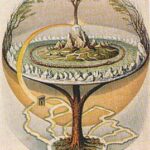The heathen faith practiced by the Vikings (which is referred to as Asatru by modern practitioners) was a very diverse and involved religion. For instance, unlike modern Christianity (where you go to heaven, hell or the inbetween), there were dozens of places that you might go after death according to the Norse. Those who died virtuous in battle might be chosen by the valkyries to go to Valhalla and train with Odin, or they might go to Sessrumnir and serve in the army of the heavens under the goddess Freya. Those who died at sea might be drug down into the halls of the sea god Aegir and his wife Ran. Those who died as faithful husbands and wives might be allowed into the hall of Frigga, Odin’s wife, where they can continue their fidelity for all time. And those who died an inglorious, or an ignoble death, would go to Hel.
Hel (spelled with one L) is both a person and a place. The daughter of the trickster god Loki and the giantess Angrboda, Hel was born one half as a beautiful goddess and one half as a rotting corpse. The sister of Fenrir (the giant wolf who bit off the hand of the war god Tyr), and of Jormungand (the world serpent who was the sworn enemy of the thunder god Thor), Hel (or Hela as she’s sometimes called) was cast out of Asgard by Odin. The realm that she fell to was in the far north, called Nifleheim, and it lies at the base of the world tree’s roots.
Gods and goddesses don’t just stop existing because there’s familial issues, and Hel was no different. Embracing the barren, frozen realm that she’d been sent to, Hel made it her own. Though it isn’t said how Nifleheim was translated from a great and empty wasteland that held only the dragon Nidhogg and into a realm filled with cold hearths and poisoned serpents, but it did happen.
Much like the mistress who ruled over the realm of death, Helheim was a two sided coin. On the one side it was a place where liars, adulterers, thieves and murderers would be punished according to their crimes. On the other side of the coin, Helheim was also a place where those who didn’t fit any other god or goddess’s requirements were sent to. Those who had died virtuous, or at least absent of misdeeds, who had not been taken in battle and who may not have a great love to unite with, found themselves in the other half of Helheim. It wasn’t heaven, but it was warm and comfortable and it wasn’t filled with freezing cold and rains of burning venom either.
Though she is mentioned in the pagan myth of Ragnarok (the Viking version of Armageddon), and it’s usually assumed that she will side with her father and brothers, Hel doesn’t seem to play a big part in the end of the world. Nor does it seem like she would. Though cold and unsympathetic, Hel cares very little for the doings of the rest of her family, and for that matter anyone who is alive. Despite this though, she fills a very important niche in Norse myth, even if she is mentioned very rarely in the tales told of the Aesir.
“Hel,” by Anonymous at God Checker
“Hel,” by Anonymous at Britannica





